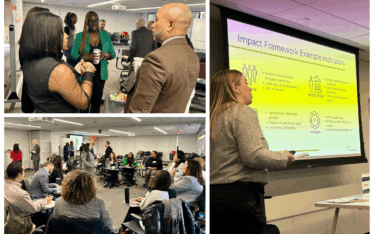The future of work is upon us. We are no longer waiting for disruptive technology to change the way we work or to see how the relationship between employees and employers will evolve. Market shifts, employment models, and workplace practices unfolding around us have serious implications for how we orient our systems to help connect young adults to economic opportunity. JobsFirstNYC’s mission is to create and advance new solutions that break down silos, transform the systems supporting young adults and their communities, and help them pursue economic opportunities. We have serious questions about whether our education and workforce systems are prepared to meet the needs of a rapidly shape-shifting economy.
Media headlines, panel discussions and events, and kitchen table conversations about the future of work are often circular, overwhelmed with complicated and incomplete data, scary, and lack a shared framework for how to develop an approach and ideate solutions.
Take, for example, the recent and much-needed hype around clean and sustainable energy and the impact this could have on the economy and the future of work. The sector is mostly driven by public investment and policy reforms, with the potential to transform significant portions of America’s economy, in addition to saving our environment. New paradigm shifts are pushed by ideas such as Rep. Alexandria Ocasio-Cortez’s- Green New Deal, New York Governor Andrew Cuomo’s call for 100% emission-free electricity, and the New York City Council’s recent mandate to retrofit all buildings and decrease carbon emissions by 40% by the year 2030. The growing energy (no pun intended) for these large-scale public investments and major policy initiatives begs the questions:
- What will the future of work look like within the clean energy sector?
- How will the sector’s growth impact other areas of the economy?
- How do we prepare the workforce of tomorrow?
In helping to pilot the Aspen Institute’s recently released Toolkit to Engage Employers and Opportunity Youth on the Future of Work, JobsFirstNYC launched an inquiry to further understand how employers, workforce providers, and young adult employees are thinking, talking, and acting in response to questions about the future of work in the clean and sustainable energy sector. Critical to our investigation was having a shared inquiry framework outlined in the toolkit that allowed us to ask a similar set of questions to different stakeholders who are all impacted by changes in the sector but likely have a different point of view and experience.

Using the toolkit helped us gain deeper and practical insight into the sustainable energy sector. For example, we learned about technology investments the state’s energy utility authority is making. One example is a five-year project to replace meters that are read by human “Meter-Readers” with smart meters, effectively replacing an entire occupation in the sector with computers. However, this project will also create a new occupation, as trained technicians will be needed to analyze and compute the results of data from smart meters. And field technicians will be needed to maintain the new smart meters. We also learned that the sector’s financial model is based on big, multi-year contracts funded by government investments. For workers, these dictate the type of job and length and terms of work, which is often structured as contracts, with the result that many workers are not employees and do not receive valuable employment benefits like health care or retirement. During interviews, both young adult workers and workforce development practitioners acknowledged the precarity of the contract arrangement, but also expressed shared optimism about growing investments in clean energy. A young adult working as a contract worker to replace old light bulbs in public housing with new, more energy-efficient light bulbs shared, “We didn’t know if we were going to have a contract with Con Edison (local energy company) but with a recent multi-year contract, we expanded our territory and are now hiring more.” To him, this meant he had a job for the next few years.
For JobsFirstNYC, using the toolkit was just one part of our work to learn more as we continue to develop and test new ideas that can expand economic mobility for all young adults and the communities in which they live. This includes reimagining career readiness and postsecondary pathways in 12 Transfer High Schools in New York City. They serve overage, undercredited students and work to stem the flow of young adults who leave the K-12 system without diplomas and become part of the out-of-school, out-of-work population. It also includes supporting place-based partnerships with resources to explore opportunities and connect, leverage, and increase education and workforce development capacity.
Share
- What does the move toward clean energy mean for the future of work? How can we prepare the workforce of tomorrow? On the @AspenInstitute blog, @KevinStump of @JobsFirstNYC talks #opportunityyouth in the #futureofwork.
- Learn how the #OpportunityYouth Toolkit (by @AspenWorkforce & @AspenFCS) helped @JobsFirstNYC learn about new strategies to expanding economic opportunity for young adults in their communities. VP @KevinStump shares his insights.
- The future of work is happening now. How can changes we can see today help our education and workforce systems meet the needs of young adults and prepare them for changing work opportunities?





